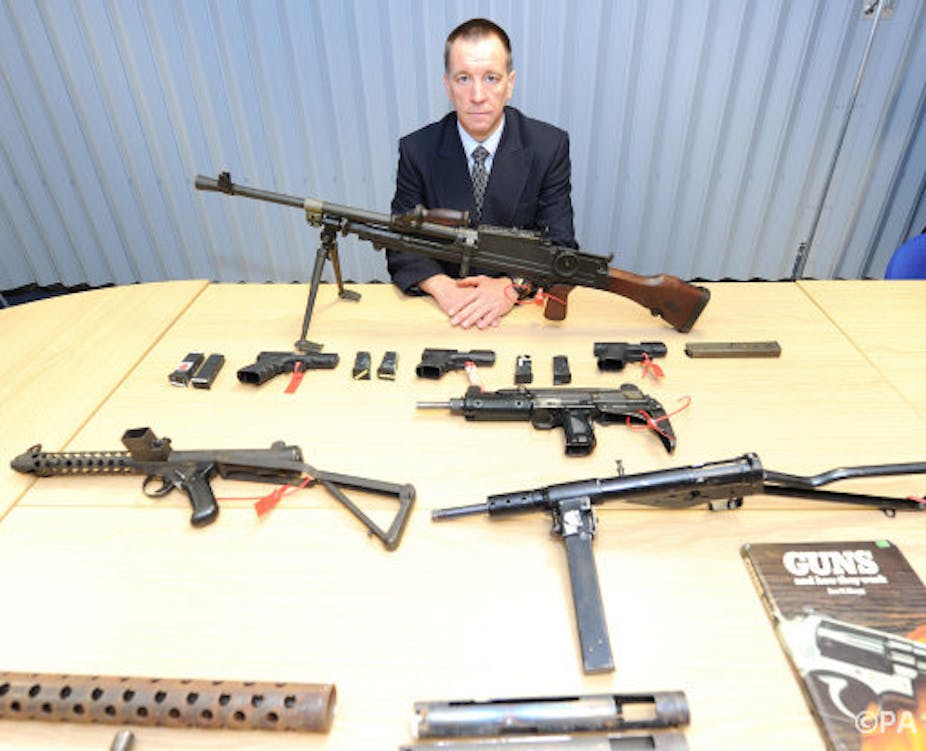Seemingly every day, the news provides examples of the deadly consequences of weapons falling into the hands of criminals, pirates, terrorist groups, rebels, and oppressive regimes. A natural reaction to these events is to blame a lack of effective weapons export controls, and to hold arms exporting countries responsible for the weapons’ misuse. But the reality of illegal access to weapons is much more complex, and it can be very difficult to pinpoint the “diversion point”: the moment when a weapon ends its “legal” life and begins its “illegal” one.
When we look at the arms trade, we must distinguish between the international transfer of conventional weapons (for example warships, battle tanks and handguns) and that of products for civilian purposes which could potentially be used to produce weapons – so-called “dual-use” technologies, such as chemical agents. While in some cases the illegal channels of supply for both may be the same (non-licensed brokers, organised crime, terrorist networks), these two categories are not, and could not be, regulated in the same way.
To demonstrate the challenges, let’s focus on the transfer of conventional weapons or arms – and more specifically, on small arms, from pistols to assault rifles.
Small in all but number
Small arms are responsible for armed violence in many different contexts, from urban violence to conflict and crisis zones, from organised crime to piracy and terrorism. There are an estimated 875 million of them in circulation worldwide, produced by more than 1,000 companies from nearly 100 countries, with an estimated annual authorised trade that exceeds $8.5 billion. According to the United Nations Register of Conventional Arms, more than three million small arms were exported in 2012.
To fully understand the scale of this market, just look to other examples of reported exports in the same year: 760 battle tanks, 7,698 missiles and missile launchers, 177,195 large calibre artillery systems (canons and rockets).
The sheer number of small arms in circulation poses a massive challenge to arms control efforts. This challenge is exacerbated by their shelf life; if properly maintained, small arms can operate for several decades and pass through many hands before the end of their lives.
The transition from the legal to the illegal realm can occur at any stage of a weapon’s life cycle: manufacture, first delivery, domestic or international transfer, possession, storage or final disposal. So irresponsible export practices are only one of the many ways small arms get into the black market. In fact, a significant number of legally acquired small arms enter the illegal trade through corruption, seizure, theft and loss.
Accordingly, various regulations target every stage of weapons’ lives to prevent their unauthorised possession and misuse. Political will and appropriate legislation are the foundations of an effective arms control process, but because of the intrinsically international nature of the arms trade, only coherent and coordinated action at regional and international levels can ultimately keep weapons away from unauthorised users.
A historic milestone was reached in April 2013 when, after almost a decade of negotiations, the United Nations General Assembly adopted the Arms Trade Treaty (ATT), a legally binding agreement that regulates the international trade in conventional arms. The ATT has so far been signed by 116 countries, but has not yet come into force.
Besides the principles included in the ATT, practical control measures for transfers of weapons are included in several regional and international agreements developed in the past 13 years. These measures focus on those responsible for the transfer (through a set of licensing criteria), transfer authorisations (including end-user certificates) and post-delivery restrictions (such as, for example, restrictions on re-export, delivery verification certificates and physical checks).
Brokers
Regulators must also consider the role played by individuals who facilitate legitimate arms deals, but who may also assist in the illegal transfer of weapons to unauthorised users or destinations: arms brokers. The definition of a broker given by the United Nations is: “a person or entity acting as an intermediary that brings together relevant parties and arranges or facilitates a potential transaction of small arms and light weapons in return for some form of benefit, whether financial or otherwise”.
By working across they various parties involved in arms deals, brokers are able to exploit some countries’ loose controls. By exploiting legislative loopholes and the lack of multilateral cooperation in arms controls, illicit brokers are often perfectly able to transfer weapons to conflict or crises zones in violation of arms embargoes. In the past 15-20 years, an increased understanding of the consequences of illicit brokering, along with ways of tackling it, have been included in several regional and international initiatives and translated into national legislation.
The UK, for instance, is a signatory of the ATT, and has national legislation to support the implementation of small arms control measures set up by both regional and international agreements. This means the UK can prosecute individuals for illegally trading small arms beyond its borders, a crucial part of arms trade policing. In 2010, for example, two arms dealers were found guilty of breaching the UK’s trafficking and brokering legislation relating to small arms for moving high explosive bombs and ammunition to Sri Lanka and Israel and sentenced to sixteen years in jail.
We must combat the illegal trade in weapons using laws, regulations and control measures. The idea that arms-exporting countries are primarily responsible for the diversion of weapons to illegal users is a misconception. While states are clearly important, substantial amounts of weapons enter the illegal market years after their export. The responsibility for preventing illegal trade must therefore be as international as the trade itself.

